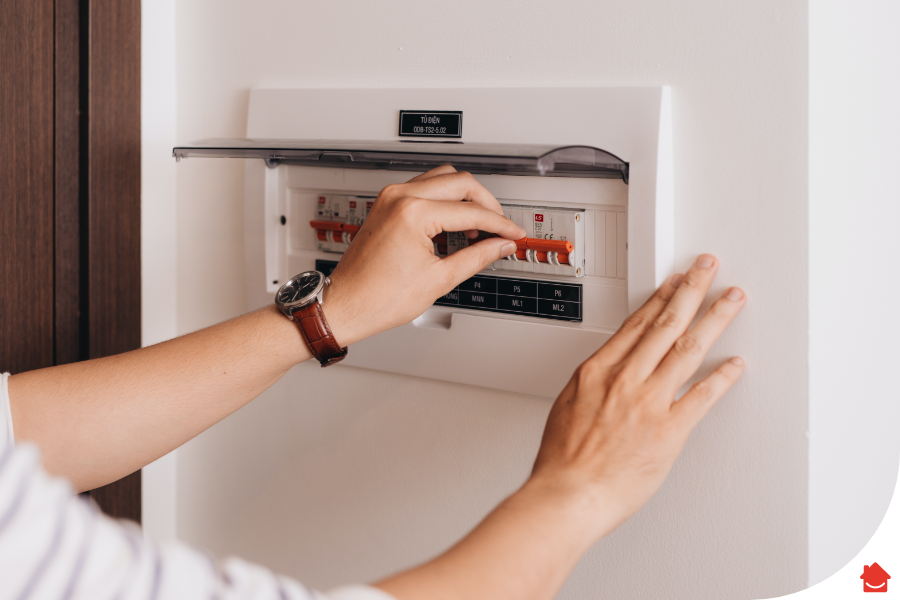If you’re the landlord of one of the draughtiest properties in England, be warned – it won’t be allowed to stay that way. Did you know that the laws around Energy Performance Certificate (EPC) ratings for rental properties were changed in 2020/2021 and landlords can now be fined up to £5,000 if your property is found to have an energy efficiency rating of F or G?
This government crackdown is an attempt to improve the overall energy efficiency of buildings in the UK’s private rented sector, which has 6.3% F and G rated properties – the biggest share of non-energy efficient homes in the country.
This guide for landlords will help you understand the latest regulations and show you how to improve your EPC rating and the benefits you can reap while doing so.
What is an EPC certificate?
An EPC (Energy Performance Certificates) is a report that assesses the energy efficiency of properties and recommends specific ways in which it can be improved. It gives your property a colour-coded grade (A – G) that gives would-be renters (or potentially buyers) an idea of how much energy bills will cost.
EPCs were introduced in 2008 to improve the baseline standard in the UK. However, some homes still rank poorly, despite there being a number of competitive advantages to landlords shifting to a ‘green’ model.
Why are landlords getting fined over their EPC?
From 1st April 2020, landlords who rent out a property with an EPC rating of F or G can now face a civil penalty of up to £5,000 for non-compliance with the government’s new Domestic Minimum Energy Efficiency Standard (MEES) regulations.
MEES regulations set a minimum energy efficiency level for domestic, private rented properties – if your property’s EPC rating is E or above, you’re compliant with the regulations and can breathe a sigh of relief – at least for now (more on the government’s 2022 plans later).
However, if your property has an EPC rating of F or G, you’re breaking the law and could potentially be looking at a sizable fine – which would vary, depending on the length of the breach of regulations.
It’s up to tenants to let the First-Tier Tribunal General Regulatory Chamber know if they feel their landlord is breaching the legislation and raise a case.
How many properties are rated F to G?
According to the Residential Landlords Association (RLA) in 2019, about 290,000 rental properties had an F or G rating that needed to be improved in line with the new regulations, before they could be put on the market for new tenancies.
Have improvements been made since the 90’s?
Big improvements have been made since the 90’s but we still have an urgent need to reduce carbon emissions. Back in 1996, 39% of rental properties had an F or G rating, so the introduction of the EPC rating system contributed to a massive overall improvement. By 2016 the figure was 7%, and now we stand at 6.3%.
Because of the urgent carbon emissions timeline, the government says this means there are up to 285,000 properties in need of urgent work.
Does this affect my property?
Most landlords won’t be affected by the new regulations as their properties already meet the requirements. However, there’s still a small subset of rental homes that don’t. Older and period properties, for example, just weren’t designed with energy efficiency in mind, so it’ll take a lot of work to make the necessary changes to get them up to scratch.
Will the minimum requirements rise to C or D in 2022?
Potentially, yes. The government is considering moves to raise the minimum requirement to C or D by 2022, so landlords are well advised to think ahead and get on top of this, while reaping the benefits of owning an energy-efficient property.
Can I access a copy of my EPC online?
Yes. If you don’t have a copy of your property’s EPC, you can usually access a copy online, if one already exists. If your property is in England or Wales, enter your postcode into the Landmark register. In Scotland, check the Scottish EPC Register.
How your EPC is calculated
Your property’s EPC rating is based on:
- The amount of energy used per m²
- The level of carbon dioxide emissions (given in tonnes per year)
Why are there two ratings on my EPC?
Your EPC rating includes your current rating and also your potential energy efficiency rating. This is an estimation of the EPC rating you might achieve if you were to make energy efficiency improvements.
How long does my property’s EPC rating last?
Once issued, your EPC is valid for 10 years – if your EPC is older than 10 years, you’ll need a new one issued before you can sell or rent your house.
Will the minimum requirements rise to C or D in 2022?
Potentially, yes. The government is considering moves to raise the minimum requirement to C or D by 2022, so landlords are well advised to think ahead and get on top of this, while reaping the benefits of owning an energy-efficient property.
What are the benefits to landlords of renting out an energy-efficient property?
Even if you’re not living in the property, you can benefit financially from keeping it as energy efficient as possible. Here are three great reasons to stop those draughts:
- If you look after the energy efficiency of your property, it can increase the value and desirability of it, which means you’re more likely to have it occupied, more of the time.
- Warmer homes and cheaper energy bills mean happier tenants. Because they’re not forking out on huge monthly bills, they have more disposable income – this also makes rent arrears less likely, saving you a headache.
- If you have energy efficiency measures in place, you’ll have lower maintenance bills and call-outs because you’ve reduced the likelihood of mould, damp, condensation and freezing pipes – all big hassles for landlords.
How to make your rental property more energy efficient
If you’ve checked your property’s EPC rating and it’s a F or a G, which is not at the required standard, you’ll need to act fast. If it’s a D or an E, you’ll want to get that rating up in preparation for the potential hike to a minimum requirement of C or D by 2022.
Or, if you’re a forward-thinking landlord who wants to further improve your EPC rating to appeal to growing numbers of eco-conscious tenants, we’ve put together the five best ways to do it.
Think about what’s most cost-effective. It might be that you can make a number of these changes at the same time. Eg. do insulation, windows and heating systems in one fell swoop, rather than doing things piecemeal, especially when you consider all the labour and materials it would entail.
1. Upgrade to LED light bulbs
Take advantage of this quick-win. If your EPC rating is dwindling on the margins of E towards F, it might only take a simple switch from old halogen or incandescent light bulbs to LED light bulbs to lift your property up one or two ratings.
Light-emitting diodes (LEDs) save you money on your electricity bill because they are much more energy-efficient and eco-friendly. Although they cost a little more to buy, they can last for 20-30 years! Make sure you replace all your bulbs this way.
2. Insulate your house
This is one of the most impactful changes you can make, and it’s not surprising because you lose so much heat through your roof (25%) and walls (35%). The remaining 40% is lost through doors, windows and the floor – we’ll get to windows next.
We thoroughly recommend insulating your property, as it’s likely to cost you less than alternative improvements, and it won’t cause a huge upheaval to your tenants. Plus, it’ll get you out of the danger zone of E, F and G – fast. Hitting the magic measurement for increasing insulation in the loft with 270mm thick (at least) boards or wool, for example, will significantly reduce the amount of heat escaping through the roof.
How to install loft insulation
Loft insulation is a fairly quick task that is easy for a moderately skilled DIYer to do and it’s a low-cost place to start in your energy efficiency journey.
How to install cavity wall insulation
Installing cavity wall insulation can stop 35% of your property’s heat from escaping through the walls – average costs are £370 – £500 for a typical semi-detached property. Considering the huge impact it could have on your overall EPC rating, this one’s a no-brainer.
You’ll need to get a professional in to install cavity wall insulation (and you’ll need cavity walls rather than solid walls).
3. Invest in double or triple glazed windows
If you’ve tackled your insulation woes, next are your windows. Older windows could actually be responsible for up to 40% of the heat loss in your property, so if you’ve had the same windows for a good while, it’s a great idea to install high- performance glazing. This will make a massive difference to the energy efficiency of your property.
Not having double-glazed windows might be why some properties haven’t reached the minimum required EPC rating of E – and getting them installed could raise your score by a grade or two, at around a £2k-£5k price tag estimated for a terraced house.
Triple glazing goes one step further. Although it’s an increasingly popular measure that will make sure your heat won’t make a great escape, you’ll be making minimal gains for the cost. It would be wiser to tick off all the other measures on the list before shelling out for triple-glazed windows.
4. Install a more efficient boiler
If you’re going to optimise for energy efficiency, heading to the source of the heat is a wise move. Your central heating system is the foundation of your property’s EPC rating and represents a significant chunk of energy costs at a whopping 55%.
If you’ve got an old boiler with an appliance rating of ‘G’, it’s no wonder your home is inefficient. Replace your boiler with a new A-rated condensing boiler that includes a programmer and thermostat and you could soon get your property out of the regulations danger zone. A new, A-rated boiler is likely to cost between £1k and £3k, but this will make your property significantly more energy efficient and attractive to new tenants, by saving on heating costs (based on a detached house).
5. Install a smart meter
Smart meters are a great way of letting your tenants see how much energy they’re using whilst encouraging them to tweak their behaviour to become less wasteful. When a person can see the exact cause and effect of their habits, and how that relates to the amount of disposable income they have at the end of the month, it’s remarkable how thrifty that person can become!
Government financial help may be available (via your tenants)
Under the UK Government’s Affordable Warmth Initiative, if your tenants claim certain benefits, you may be able to get financial help for making energy-saving improvements to your property. These benefits include Child Tax Credit, Working Tax Credit and Universal Credit.
In the meantime, check out our complete guide to replacing and installing a new, energy efficient boiler. And if you have any questions, get in touch and we’d be happy to help.
FAQs
How do I increase my EPC rating?
- Upgrade to LED light bulbs
- Install house insulation
- Install double or triple-glazed windows
- Install a more efficient boiler
- Install a smart meter
What is the minimum EPC rating for a rental property?
A rental property must have an EPC rating of E or above. Since 1st April 2020, it’s unlawful to rent out a home that falls below the EPC rating of E, unless there’s an applicable exemption.
Is an EPC rating of D good?
It doesn’t fall foul of the UK government’s new minimum requirements for energy efficiency – yet. But it’s not going to win you any prizes – landlords and homeowners can improve and save energy and money by following the steps we’ve laid out.
What is a bad EPC rating?
UK laws around Energy Performance Certificate ratings for rental properties were changed in 2020/ 2021 and landlords can now be fined up to £5,000 if your property is found to have an energy efficiency rating of F or G.




